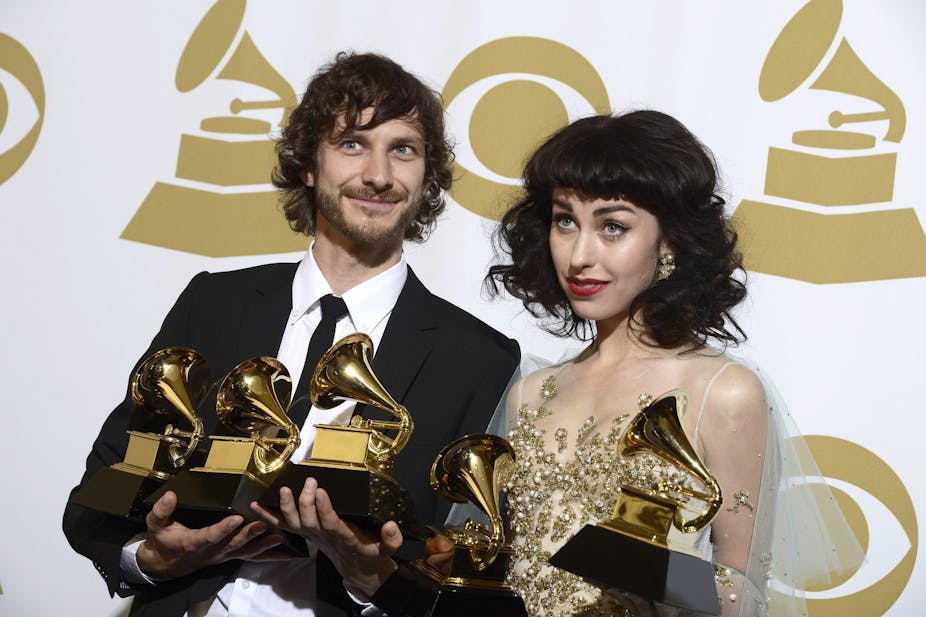Recently on The Conversation, [Julian Meyrick asked](http://theconversation.com/does-australia-get-culture-18327](http://theconversation.com/does-australia-get-culture-18327) why Australians didn’t get culture.
Seems a strange question when Australian actors star in many US TV series. And when Australian singer Gotye topped the US charts last year with 6.8 million downloads of the Grammy-winning Somebody that I used to Know.
If we’re not getting culture, some bodies elsewhere are certainly getting a lot of our cultural offerings.
Some would dispute that Gotye is “real” culture, or that downloads are a useful measurement. But those two comments in themselves stoke the debate. Because the oft-repeated comments denigrating Australians and culture rarely define their terms. Though they often have an unstated bias for “high culture” such as opera, ballet and the like.
And they virtually never include any sensible statistics to measure their claims.
In fact, on almost any measure you like to use, Australians get culture in a big way. We have remarkably good cultural attendances and participation. Despite long-standing ideas of a cultural cringe, we always have.
Key figures
Let’s kick one furphy out of the park for starters. Since colonial times, many sneerers have claimed our obsession with sport precludes any appreciation of culture. Despite many repetitions, it’s always been nonsense.
I checked cross-overs between sports and cultural attendances by organising a special run of the Australian Bureau of Statistics’ 2010 Household Survey.
I found that 33% of AFL fans also visit art galleries – well ahead of the 24% of non-footy fans who go to galleries. The comparisons are similar for other sports and other cultural activities.
But most critiques presume some sort of international comparison, suggesting that if we don’t get culture, there must be some countries out there that do.
A good place to start is a report London Mayor Boris Johnson launched last year – the World Cities Culture Report 2012 – which compared 12 major world cities, including Sydney.
The report reckoned there is no one metric for “culture”. It compared 60 different cultural measures, covering both formal culture, in museums, theatres and galleries, and informal culture in pubs and festivals.

Australia’s representative Sydney is far from shabby in the comparisons. It does particularly well on numbers of students doing art and design degree courses, the number of bookshops, and the number of festivals.
For its size, Sydney has similar cinema attendances to Paris, which the report termed “the city of film”. Melbourne also does well on the various measures – even higher cinema attendances and a remarkable music scene, with more live music venues than London, Paris or New York.
These are just a few of the possible comparisons. Australian cities do not do as well on some other things, such as the number of restaurants – although that’s probably affected by our smaller number of tourists. But there’s certainly nothing here to suggest Australians don’t get culture.
Other sources show a similar picture. Earlier this year The Art Newspaper listed the 100 art museums around the world that attract 650,000 or more visitors a year.
Australia has an impressive eight on the list, with both the Queensland Art Gallery/GoMA and the National Gallery of Victoria topping our numbers at 1.5 million. Unlike many others that are major tourist drawcards, our galleries rely mainly on a local audience.

Widening the net
Let’s try some broader comparisons with Australia.
A quarter of Australian adults go to art galleries each year – ahead of the fifth going in the United States. When it comes to attending musicals and theatre, our 25% is well ahead of the US, at 18%, and similar to the UK’s, at 24%.
And in the home of Hollywood, 59% of Americans go to the movies: the Australian figure is 67%.
These levels of cultural activity are far from a recent phenomenon. After the gold rushes, the wealth of the colonies encouraged a flourishing cultural scene. Two Melbourne publicans, Spiers and Pond, organised the first English cricket tour of Australia, in 1861-2.
Following that success, they brought leading Shakespearean actor Charles Kean to Australia two years later.
Early readership levels were high. In 1900, The Age in Melbourne had a daily circulation of 120,000, when The Times in London had 38,000.
Melbourne had three other daily papers, and the major Victorian regional centres also had dailies.
Readership patterns also featured in AA Phillips’ celebrated 1950 article on the “cultural cringe”. Phillips was actually strongly critical of the cringe, criticising the lack of evidence for supposed British cultural superiority.

He noted the high levels of Australian newspaper readership and per-capita purchase of books. These, he thought, “would suggest that in fact our cultural attainments are rather above the average Anglo-Saxon level”.
The late Robert Hughes, one of a number of cultural expats who left Australia in the 1960s, noted (with surprise) a similar statistic for the early 1960s.
None of this suggests an Australian “exceptionalism”. Much was due to a well-off urban society. But it certainly challenges the frequent complaints about cultural deserts here.
For much of Somebody that I used to Know, Gotye laments a failed relationship. The song takes a perspective twist when co-singer Kimbra joins with a scathing, “When I think of how you screwed me over”.
Many denigrating Australian culture have, for a long time, been screwing the rest of us over. The evidence is clear that the barbs have little to back them up. So why have so many persisted with the myths?
That might be the subject of another article.
Further reading:
Do Australians ‘get’ culture?

